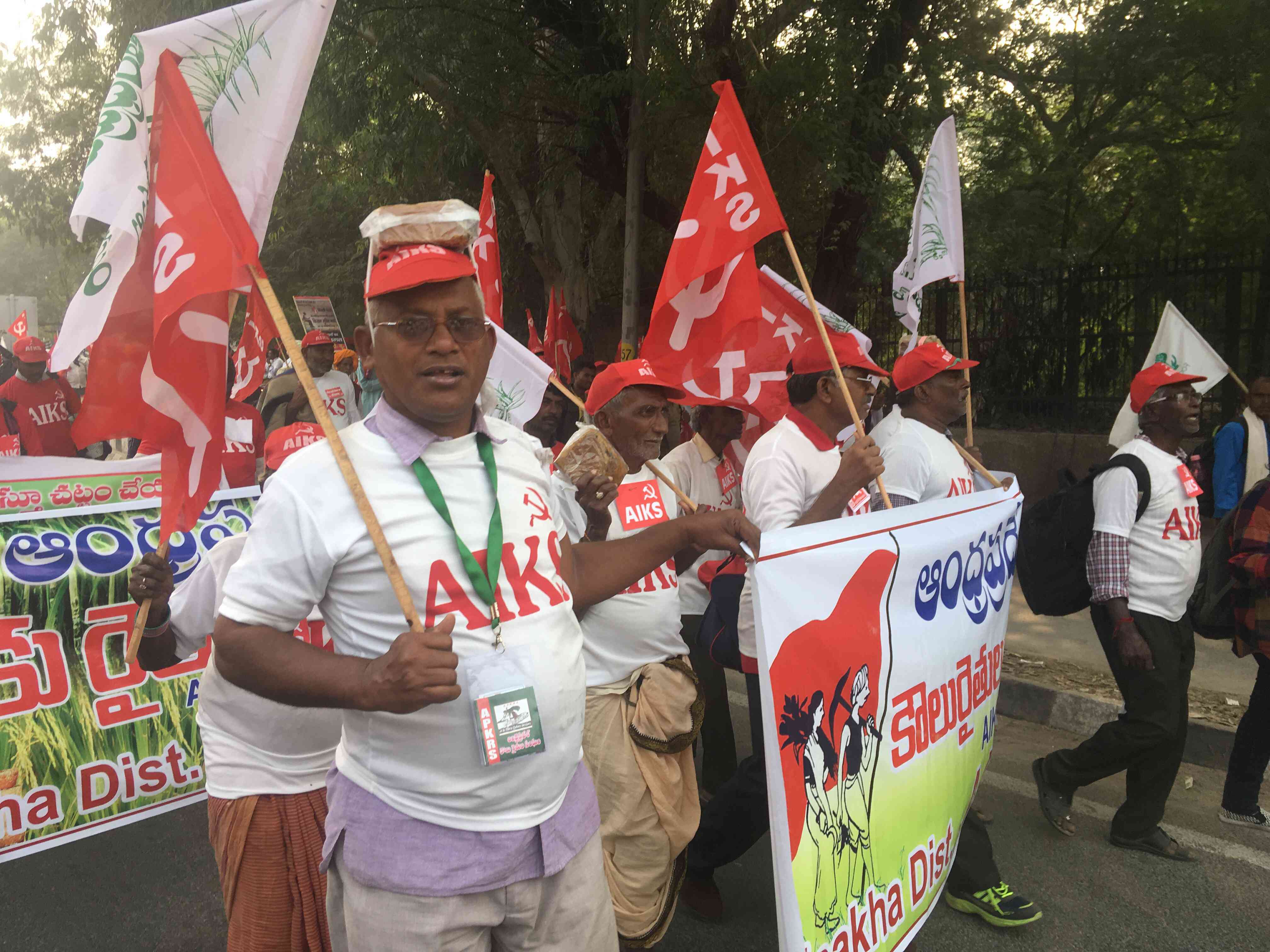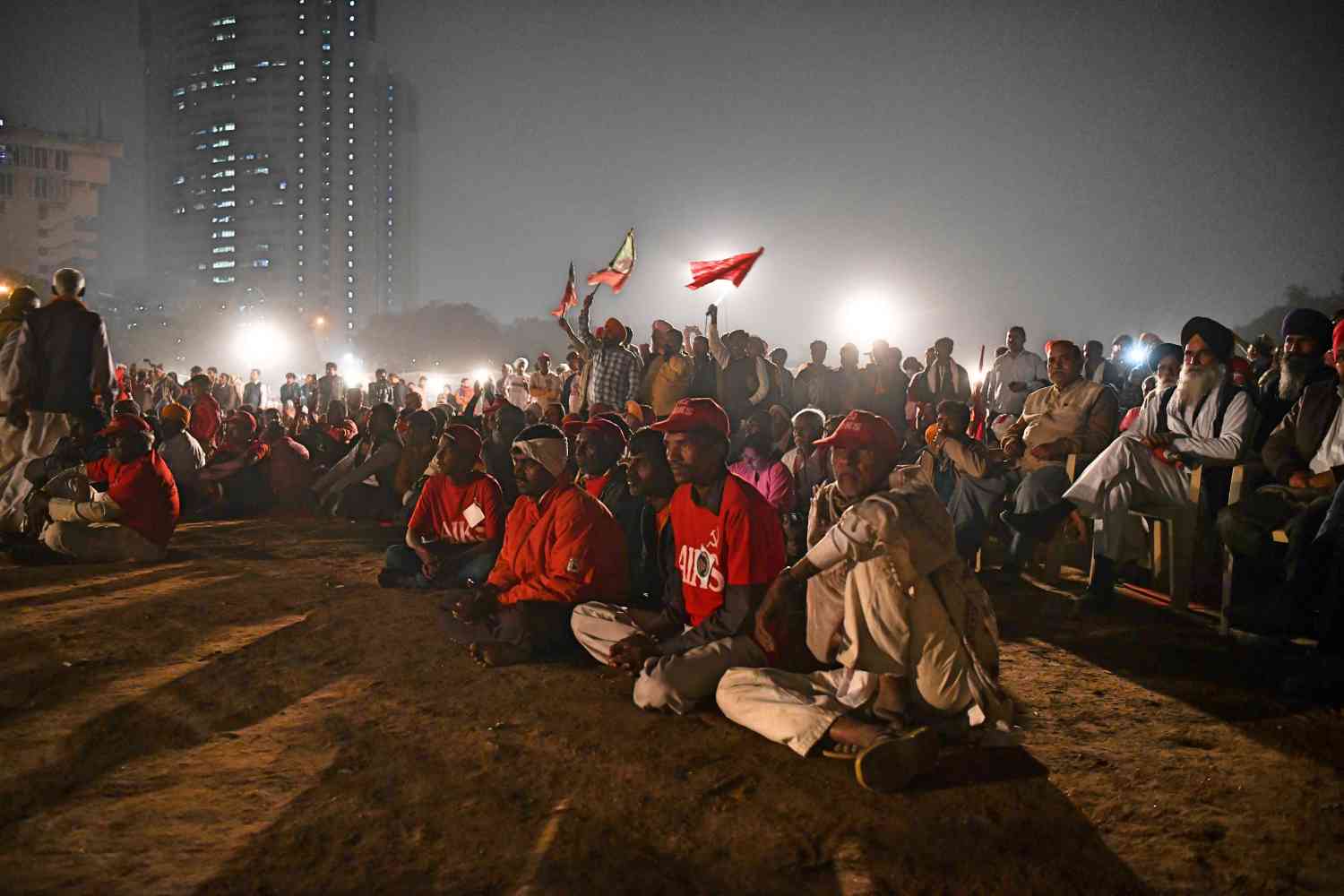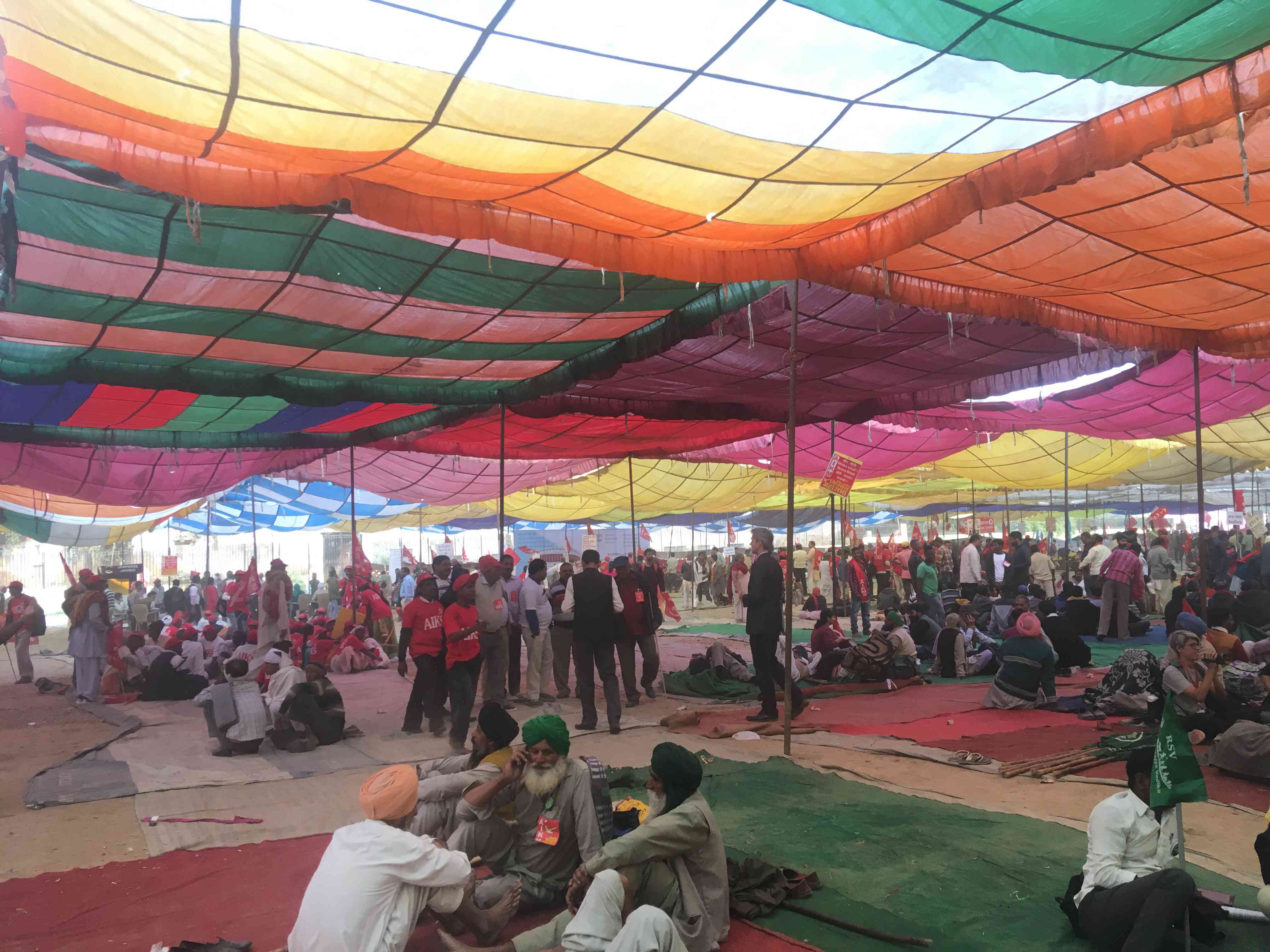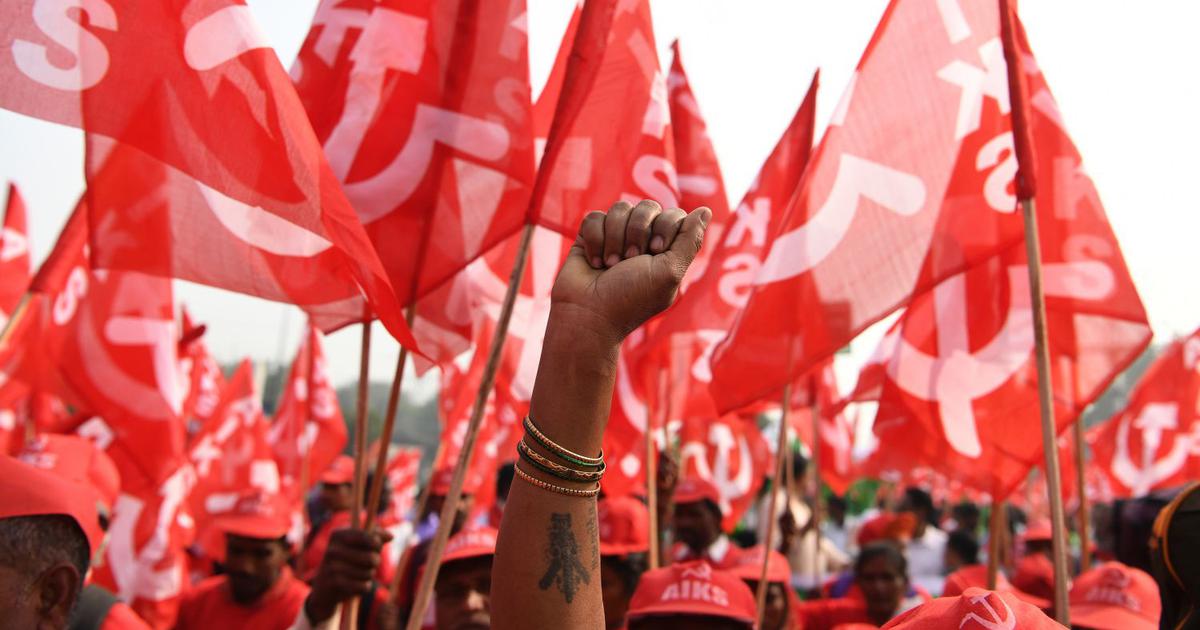On Thursday afternoon, as a sea of farmers carrying red flags and banners marched from Indraprastha Park in East Delhi towards Ramlila Maidan in central Delhi, Anil Kumar, a police officer, looked on sceptically. “I can bet that 80% of these farmers do not even know what their demands are,” he said. A few moments later, three farmers from Haryana tapped him on his shoulder and said: “Ask us right now, we will tell you.”
These farmers were among thousands of others – from Punjab, Haryana, Andhra Pradesh, Telangana, Madhya Pradesh, Rajasthan, Chhattisgarh, Tamil Nadu, West Bengal and Odisha – who converged in the national Capital on Thursday for the Kisan Mukti March organised by the All India Kisan Sangharsh Coordination Committee, a coalition of around 200 large and small farmer groups from across India. They first assembled at various points in the city and then walked to Ramlila Maidan. On Friday, they will march to Parliament with their demands.
“We voted and then hopped on to a train to make it to Delhi,” said Raichand, 50, a farmer from Jhabua district in Madhya Pradesh, which voted for a new Assembly on Wednesday. “We are very angry with the Central government,” he said. “They have not fulfilled any of the promises they made for farmers.”
The farmers are demanding a Joint Session of Parliament to discuss the agrarian crisis, the implementation of the MS Swaminathan Commission report, increased minimum support prices, and the passing of the Farmers’ Freedom from Indebtedness Bill, 2018, and Farmers’ Right to Guaranteed Remunerative Minimum Support Prices for Agricultural Commodities Bill, 2018, which were tabled in the Lok Sabha in August by Hatkanangle MP Raju Shetti, leader of the Swabhimani Paksha, an independent farmers’ political party in Maharashtra.
At Indraprastha Park, Malkit Singh, 74, a farmer from Haryana, speculated about what it would take for the Bharatiya Janata Party-led Union government to implement their demands, especially the implementation of the Swaminathan report. “If they lose elections in all five states, then they will surely implement it,” he said, referring to the ongoing Assembly polls in Madhya Pradesh, Rajasthan, Chhattisgarh, Telangana and Mizoram.

‘It is time for our demands to be met’
Like the Haryana farmers who enlightened the policeman about their demands, the men and women who marched into Delhi on Thursday knew exactly what they wanted.
Alivelamma, 35, a farmer from Anantapur district in Andhra Pradesh, is hopeful that the Centre will waive farmers’ debts and pass the two bills. Her farmer husband committed suicide five years ago and she said she has received no support from the government since. “I have been attending all the previous farmers’ marches,” she said at Indraprastha Park while on her way to Ramlila Maidan. “For many years, farmers have struggled and now it is time for our demands to be met.”
Nagi Reddy Satyanarayana, 59, a sugarcane farmer from Vishakhapatnam, Andhra Pradesh, walked with a block of jaggery on his head as did some of his companions from the state. “We are here to protest against the state government’s corruption,” he said. “The government buys jaggery from us at Rs 23 per kg but they import jaggery from Gujarat and Maharashtra at Rs 49 per kg. This is unfair on sugarcane farmers. We have realised the bad economic policies [the government is following] which is why our struggles have to be intensified.”
Kanhaiya Lal, 61, a retired bank official from Jaipur, Rajasthan, who comes from a family of farmers, said he was marching for fair procurement prices for agricultural produce. He is the youngest of 11 siblings and the only one to leave farming because of the education he received. “There is such a wide gap between what farmers get and what workers in cities earn,” he said at the Bijwasan assembly point in South West Delhi. “In 1983, when I started working as a bank clerk, my salary was Rs 780 a month. In the same year, the price of wheat per quintal was Rs 100. In 2018, before I retired, my salary was Rs 1,18,000 and the price of wheat was only Rs 2,000 per quintal. In 35 years, the price of wheat has gone up by 20 times whereas my salary went up by more than a 100 times.”
A farmer from the Sundarbans in West Bengal, who also fishes for a living, wanted the government to stop taking control of common forests and water bodies that villagers earlier had access to. “We have been stopped from fishing,” she said. “Officials say that the engines of our boats harm the environment. But when tourists come in the same boats, they let them go. We are also stopped from collecting wood.”
Another farmer from West Bengal, Subhistha Singh, 30, who also works as a mid-day meal worker in a primary school in Uttar Dinajpur district, wanted a job. “When will we get the guarantee of a permanent job from the government?” she asked at Bijwasan. “We get only one-third of our Rs 6,000 salary from the school and we earn Rs 50 a day from working on the field. We have no husbands, or fathers, how can we live with so little money?”

‘Stray cattle are a menace’
Several farmers participating in the Kisan Mukti March complained about the menace of stray cattle. “Awara pashu [stray cattle] come and destroy our fields,” said Rohtas Malik Issar, 42, a farmer from Haryana, at Indraprastha Park. He said that after the ban on the sale of cows for slaughter by the Centre last year, the government promised farmers that it would set up cow shelters to corral stray cattle. But this has not happened yet. “We cannot sell old cows so most of us end up abandoning them,” said Issar. “We have protested against the Haryana government for not helping us with this problem.”
Surjan Singh, 56, from Nagaur district in Rajasthan, added that farmers like him were facing a similar problem. “Fencing the field is very expensive,” he said. “In one night, 200 animals destroyed my fields. They will put us in jail if we beat up cattle to send them away.”
Haryana’s Malkit Singh spoke of the lengths he had to go to protect his crops. “Twenty to 30 cows ate the crops in one acre of my field,” he said. “We have to stay up all night to save our crops.”
Delhi residents step in
While several people in Delhi came out to support the farmers, even marching alongside, other city residents were baffled by the march.
“Many of us don’t even know where our food comes from,” said Priyanka Joshi, 34, a financial consultant who found out about the march on social media and joined the farmers at Indraprastha Park. “Not too many urban residents have come to the march but it is such an important cause to support.”
At the Bijwasan assembly point, the march started at 10 am. Many residents came out of their gated homes to gape at the farmers carrying yellow flags and shouting slogans about their rights. “They have all gone mad,” said Ashok Saini, 48, a dairy owner. “They are only doing this to embarrass [Narendra] Modi. My relatives are farmers and they seem to be doing just fine.”
But Vaibhav Parab, 26, a teacher from Sindhudurg district in Maharashtra, did not agree. He had come to Delhi with two of his friends to support the farmers. He had heard about the march after watching the speeches of Swaraj Abhiyan leader Yogendra Yadav on YouTube. “In our region, fishermen are competing with big corporates to catch fish,” he said, “Our farmers are also refusing to sell their produce of rice because of the low rates they get for it. They are keeping their produce with themselves.”
As the farmers who had marched from Sarai Kale Khan via Indraprastha Park halted at Raj Ghat for a short break, students and other volunteers distributed food and water. Ikramuddin, a local resident who works as a driver, stood next to a bus stop and observed the sea of farmers in front of him. “[Narendra] Modi has eaten their share that is why they are all here,” he said. “I feel that if their demands are not met, then he will lose elections next year.”



